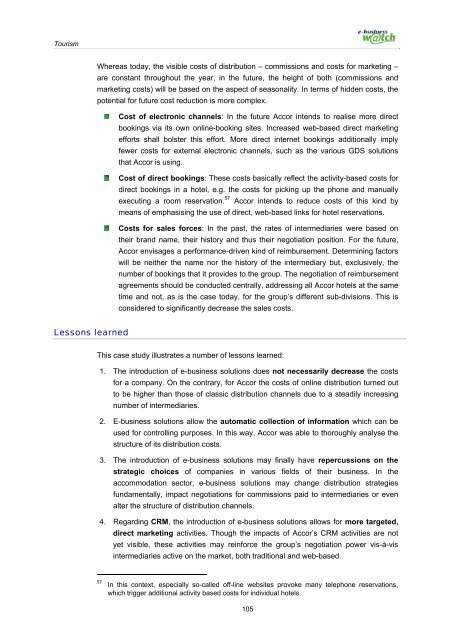ICT and e-business in the tourism industry ICT adoption ... - empirica
ICT and e-business in the tourism industry ICT adoption ... - empirica
ICT and e-business in the tourism industry ICT adoption ... - empirica
Create successful ePaper yourself
Turn your PDF publications into a flip-book with our unique Google optimized e-Paper software.
Tourism<br />
Whereas today, <strong>the</strong> visible costs of distribution – commissions <strong>and</strong> costs for market<strong>in</strong>g –<br />
are constant throughout <strong>the</strong> year, <strong>in</strong> <strong>the</strong> future, <strong>the</strong> height of both (commissions <strong>and</strong><br />
market<strong>in</strong>g costs) will be based on <strong>the</strong> aspect of seasonality. In terms of hidden costs, <strong>the</strong><br />
potential for future cost reduction is more complex.<br />
Cost of electronic channels: In <strong>the</strong> future Accor <strong>in</strong>tends to realise more direct<br />
book<strong>in</strong>gs via its own onl<strong>in</strong>e-book<strong>in</strong>g sites. Increased web-based direct market<strong>in</strong>g<br />
efforts shall bolster this effort. More direct <strong>in</strong>ternet book<strong>in</strong>gs additionally imply<br />
fewer costs for external electronic channels, such as <strong>the</strong> various GDS solutions<br />
that Accor is us<strong>in</strong>g.<br />
Cost of direct book<strong>in</strong>gs: These costs basically reflect <strong>the</strong> activity-based costs for<br />
direct book<strong>in</strong>gs <strong>in</strong> a hotel, e.g. <strong>the</strong> costs for pick<strong>in</strong>g up <strong>the</strong> phone <strong>and</strong> manually<br />
execut<strong>in</strong>g a room reservation. 57 Accor <strong>in</strong>tends to reduce costs of this k<strong>in</strong>d by<br />
means of emphasis<strong>in</strong>g <strong>the</strong> use of direct, web-based l<strong>in</strong>ks for hotel reservations.<br />
Costs for sales forces: In <strong>the</strong> past, <strong>the</strong> rates of <strong>in</strong>termediaries were based on<br />
<strong>the</strong>ir br<strong>and</strong> name, <strong>the</strong>ir history <strong>and</strong> thus <strong>the</strong>ir negotiation position. For <strong>the</strong> future,<br />
Accor envisages a performance-driven k<strong>in</strong>d of reimbursement. Determ<strong>in</strong><strong>in</strong>g factors<br />
will be nei<strong>the</strong>r <strong>the</strong> name nor <strong>the</strong> history of <strong>the</strong> <strong>in</strong>termediary but, exclusively, <strong>the</strong><br />
number of book<strong>in</strong>gs that it provides to <strong>the</strong> group. The negotiation of reimbursement<br />
agreements should be conducted centrally, address<strong>in</strong>g all Accor hotels at <strong>the</strong> same<br />
time <strong>and</strong> not, as is <strong>the</strong> case today, for <strong>the</strong> group’s different sub-divisions. This is<br />
considered to significantly decrease <strong>the</strong> sales costs.<br />
Lessons learned<br />
This case study illustrates a number of lessons learned:<br />
1. The <strong>in</strong>troduction of e-<strong>bus<strong>in</strong>ess</strong> solutions does not necessarily decrease <strong>the</strong> costs<br />
for a company. On <strong>the</strong> contrary, for Accor <strong>the</strong> costs of onl<strong>in</strong>e distribution turned out<br />
to be higher than those of classic distribution channels due to a steadily <strong>in</strong>creas<strong>in</strong>g<br />
number of <strong>in</strong>termediaries.<br />
2. E-<strong>bus<strong>in</strong>ess</strong> solutions allow <strong>the</strong> automatic collection of <strong>in</strong>formation which can be<br />
used for controll<strong>in</strong>g purposes. In this way, Accor was able to thoroughly analyse <strong>the</strong><br />
structure of its distribution costs.<br />
3. The <strong>in</strong>troduction of e-<strong>bus<strong>in</strong>ess</strong> solutions may f<strong>in</strong>ally have repercussions on <strong>the</strong><br />
strategic choices of companies <strong>in</strong> various fields of <strong>the</strong>ir <strong>bus<strong>in</strong>ess</strong>. In <strong>the</strong><br />
accommodation sector, e-<strong>bus<strong>in</strong>ess</strong> solutions may change distribution strategies<br />
fundamentally, impact negotiations for commissions paid to <strong>in</strong>termediaries or even<br />
alter <strong>the</strong> structure of distribution channels.<br />
4. Regard<strong>in</strong>g CRM, <strong>the</strong> <strong>in</strong>troduction of e-<strong>bus<strong>in</strong>ess</strong> solutions allows for more targeted,<br />
direct market<strong>in</strong>g activities. Though <strong>the</strong> impacts of Accor’s CRM activities are not<br />
yet visible, <strong>the</strong>se activities may re<strong>in</strong>force <strong>the</strong> group’s negotiation power vis-à-vis<br />
<strong>in</strong>termediaries active on <strong>the</strong> market, both traditional <strong>and</strong> web-based.<br />
57<br />
In this context, especially so-called off-l<strong>in</strong>e websites provoke many telephone reservations,<br />
which trigger additional activity based costs for <strong>in</strong>dividual hotels.<br />
105

















